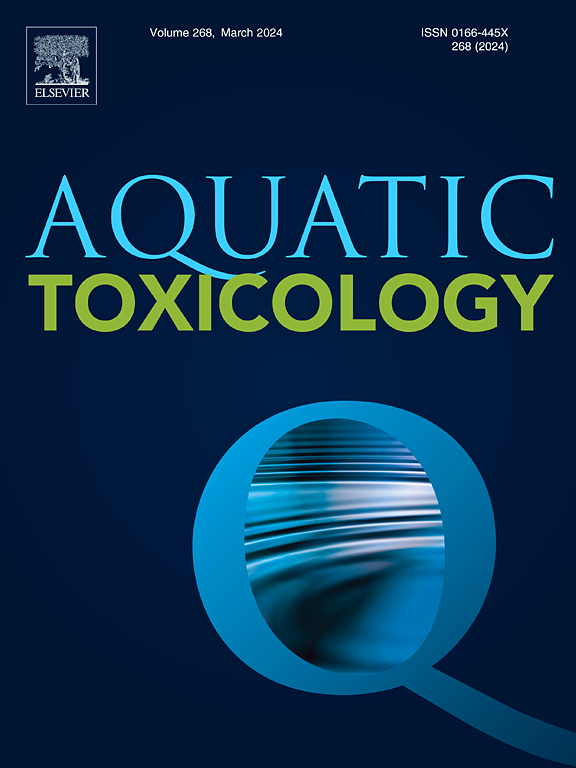Influence of CYP1A and AhR modulation on polycyclic aromatic hydrocarbon-induced developmental defects in Japanese medaka
IF 4.1
2区 环境科学与生态学
Q1 MARINE & FRESHWATER BIOLOGY
引用次数: 0
Abstract
Polycyclic aromatic hydrocarbons (PAHs) are known to induce developmental malformations in fish embryos. However, the interaction between aryl hydrocarbon receptor (AhR) and cytochrome P450 (CYP) in PAH-induced development defects remains unclear. Therefore, we investigated the effects of the CYP1A inhibitor piperonylbutoxide (PBO) and the AhR antagonist CH223191 (CH) on the development of Japanese medaka (Oryzias Latipes) embryos exposed to different PAHs. Japanese medaka embryos were exposed to three conditions: PAH alone, PAH and PBO, and PAH and CH. Microscopic observations were performed to examine the presence of developmental defects. Although neither phenanthrene (Phe) nor fluoranthene (Flu) induced morphological malformations in larvae, benzo(a)anthracene (BaA) exposure induced craniofacial deformities in the larvae. Additionally, BaA and PBO co-exposure significantly increased the rate and severity of malformations. Pyrene (Pyr) exposure induced craniofacial defects, cardiac hypertrophy, pericardial edema, and spinal curvature, which were attenuated by exposure to either CH or PBO. Collectively, these findings suggest that structurally different PAHs exert their toxic effects via distinct mechanisms during fish development.
CYP1A和AhR调控对多环芳烃诱导的日本medaka发育缺陷的影响
已知多环芳烃(PAHs)可诱导鱼类胚胎发育畸形。然而,芳烃受体(AhR)和细胞色素P450 (CYP)在多环芳烃诱导的发育缺陷中的相互作用尚不清楚。因此,我们研究了CYP1A抑制剂胡椒酰丁醇(PBO)和AhR拮抗剂CH223191 (CH)对暴露于不同多环芳烃环境下的日本medaka (Oryzias Latipes)胚胎发育的影响。将日本水母胚胎暴露于三种条件下:单独多环芳烃、多环芳烃和多环芳烃以及多环芳烃和多环芳烃。通过显微镜观察来检查发育缺陷的存在。虽然菲(Phe)和氟蒽(Flu)都不会引起幼虫的形态畸形,但苯并(a)蒽(BaA)暴露会引起幼虫的颅面畸形。此外,BaA和PBO共同暴露显著增加畸形发生率和严重程度。芘暴露可引起颅面缺损、心脏肥厚、心包水肿和脊柱弯曲,暴露于CH或PBO均可减轻这些缺陷。总的来说,这些发现表明,在鱼类发育过程中,结构不同的多环芳烃通过不同的机制发挥毒性作用。
本文章由计算机程序翻译,如有差异,请以英文原文为准。
求助全文
约1分钟内获得全文
求助全文
来源期刊

Aquatic Toxicology
环境科学-毒理学
CiteScore
7.10
自引率
4.40%
发文量
250
审稿时长
56 days
期刊介绍:
Aquatic Toxicology publishes significant contributions that increase the understanding of the impact of harmful substances (including natural and synthetic chemicals) on aquatic organisms and ecosystems.
Aquatic Toxicology considers both laboratory and field studies with a focus on marine/ freshwater environments. We strive to attract high quality original scientific papers, critical reviews and expert opinion papers in the following areas: Effects of harmful substances on molecular, cellular, sub-organismal, organismal, population, community, and ecosystem level; Toxic Mechanisms; Genetic disturbances, transgenerational effects, behavioral and adaptive responses; Impacts of harmful substances on structure, function of and services provided by aquatic ecosystems; Mixture toxicity assessment; Statistical approaches to predict exposure to and hazards of contaminants
The journal also considers manuscripts in other areas, such as the development of innovative concepts, approaches, and methodologies, which promote the wider application of toxicological datasets to the protection of aquatic environments and inform ecological risk assessments and decision making by relevant authorities.
 求助内容:
求助内容: 应助结果提醒方式:
应助结果提醒方式:


